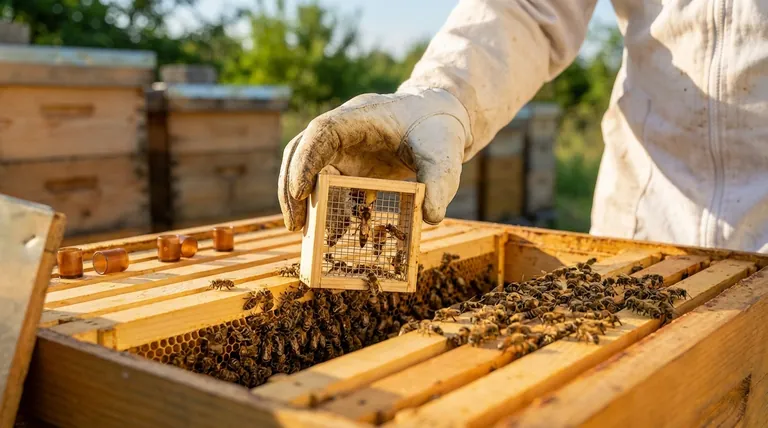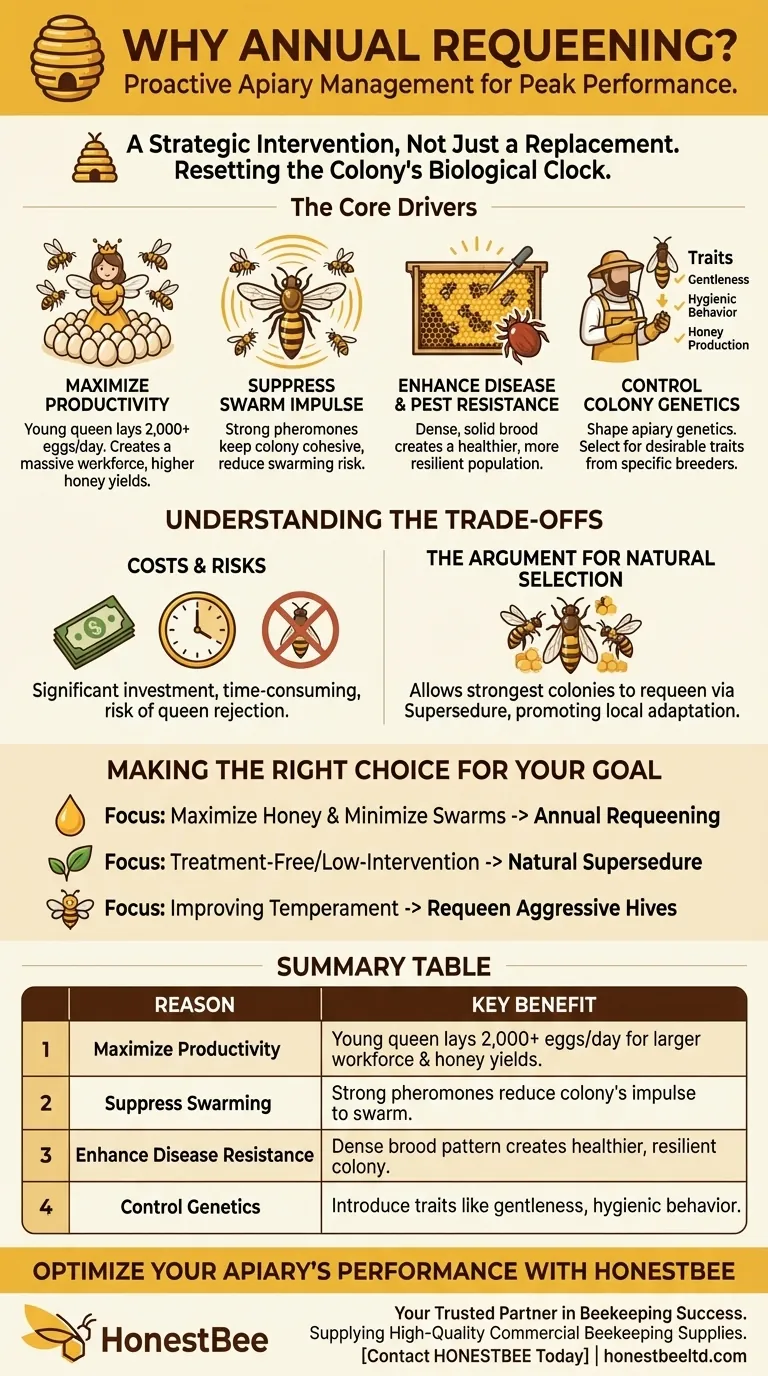At its core, beekeeping is about proactive management, and most beekeepers requeen their colonies annually to preemptively address the predictable decline of an aging queen. A young queen is the engine of a productive and stable hive, laying more eggs, emitting stronger social pheromones, and building a more robust workforce. This single action is a powerful lever for maximizing colony health and productivity.
Requeening is not simply about replacing a queen; it is a strategic intervention to reset the colony's biological clock, ensuring peak performance, minimizing the impulse to swarm, and controlling genetic traits.

The Core Drivers of Annual Requeening
Understanding the "why" behind this common practice reveals how it directly influences the key variables of colony success. It is a proactive measure against predictable problems.
Maximizing Colony Population and Productivity
A queen's primary role is to lay eggs. A young queen in her first year is at her absolute peak, often laying over 2,000 eggs per day.
This high rate of brood production creates a massive workforce of forager bees, which directly translates into higher honey yields and a stronger colony. While a queen can live for several years, her egg-laying rate begins to decline significantly after her first season.
Suppressing the Swarm Impulse
Swarming is a natural reproductive instinct for a honeybee colony, but for the beekeeper, it represents a significant loss of bees and potential honey production.
A young, well-mated queen produces a strong profile of pheromones. These chemical signals keep the colony cohesive and focused on work. As a queen ages, her pheromone output weakens, which is a primary trigger for the colony to begin raising a new queen and preparing to swarm.
Enhancing Disease and Pest Resistance
A colony's ability to fight off threats like the Varroa mite is directly tied to its health and population dynamics.
A young queen lays a dense, consistent brood pattern with few empty cells. This "solid brood" results in a healthier, more resilient population that is better equipped to manage pests and diseases. An older queen with a spotty brood pattern creates a weaker, more vulnerable colony.
Controlling Colony Genetics
Requeening is the beekeeper's most powerful tool for shaping the genetic makeup of their apiary.
By introducing a new queen from a specific breeder, a beekeeper can select for desirable traits. These can include gentleness, hygienic behavior (which helps with mite control), overwintering ability, and, of course, honey production.
Understanding the Trade-offs
While the benefits are clear, annual requeening is a management decision with associated costs and risks. It is not a universally applied rule.
The Cost and Logistics
Purchasing high-quality, well-mated queens every year represents a significant financial investment, especially for beekeepers with many hives.
Furthermore, the process of finding the old queen, removing her, and successfully introducing the new one requires time, skill, and careful timing.
The Risk of Queen Acceptance
A colony will not always accept a new queen. The bees may reject and kill her, a process known as rejection.
If this happens, the colony becomes queenless, and the beekeeper must intervene again. A failed introduction can set a colony back by several weeks during a critical part of the season.
The Argument for Natural Selection
Some beekeepers argue against routine requeening, preferring to let colonies replace their own queens through a natural process called supersedure.
The philosophy here is that allowing the strongest colonies to raise their own queens promotes the survival of genetics best adapted to the local environment and climate.
Making the Right Choice for Your Goal
Your approach to requeening should align directly with your beekeeping objectives.
- If your primary focus is maximizing honey production and minimizing swarms: Annual requeening with a young, vigorous queen is one of the most effective strategies you can employ.
- If your primary focus is on treatment-free or low-intervention beekeeping: You may choose to let strong colonies requeen themselves, promoting locally-adapted, resilient genetics.
- If your primary focus is improving temperament: Requeening an aggressive hive with a queen known for gentle offspring is the most direct and reliable solution.
Ultimately, understanding when and why to requeen is a powerful tool that shifts your role from simply keeping bees to actively managing a thriving apiary.
Summary Table:
| Reason for Annual Requeening | Key Benefit |
|---|---|
| Maximize Productivity | Young queen lays 2,000+ eggs/day for larger workforce & higher honey yields. |
| Suppress Swarming | Strong pheromones from a young queen reduce the colony's impulse to swarm. |
| Enhance Disease Resistance | Dense brood pattern from a vigorous queen creates a healthier, more resilient colony. |
| Control Genetics | Introduce desirable traits like gentleness, hygienic behavior, and high honey production. |
Optimize Your Apiary's Performance with HONESTBEE
Annual requeening is a cornerstone of successful, productive beekeeping. As a commercial beekeeper or equipment distributor, ensuring you have the right tools and knowledge is critical for maximizing honey yields and maintaining colony health.
HONESTBEE is your trusted partner in beekeeping success. We supply high-quality beekeeping supplies and equipment specifically designed for the demands of commercial apiaries and distributors.
Let us help you:
- Boost Productivity: Equip your operation with reliable tools for efficient hive management.
- Improve Colony Health: Source durable equipment that supports strong, thriving bees.
- Streamline Your Workflow: Our wholesale-focused operations ensure you get the supplies you need, when you need them.
Ready to enhance your beekeeping strategy? Contact HONESTBEE today to discuss your specific needs and discover how our products can support your goals for a more productive and resilient apiary.
Visual Guide

Related Products
- Brown Nicot Queen Cell Cups for Breeding Queen Bees Beekeeping
- No Grafting Queen Rearing Kit: System for Royal Jelly Production and Queen Rearing
- JZBZ Push-In Queen Cell Cups for Beekeeping
- JZBZ Type Wide Base Plastic Queen Cell Cups for Base Mounting and Queen Rearing
- Plastic Chinese Queen Grafting Tool for Bee Queen Rearing
People Also Ask
- What are the ideal conditions for raising good queen cells? Achieve Robust Queens with Strong Cell-Builder Colonies
- What should be done with extra queens from grafting? A Strategic Guide for Apiary Management
- What are the signs that a queen cell is about to emerge? Master the Critical Timing for Hive Success
- What is the benefit of inducing supersedure by giving a queenright colony a protected queen cell? A Seamless Requeening Method
- What is the advantage of the Nicot Cupkit system? Secure Your Queen Rearing Success with Batch Protection



















